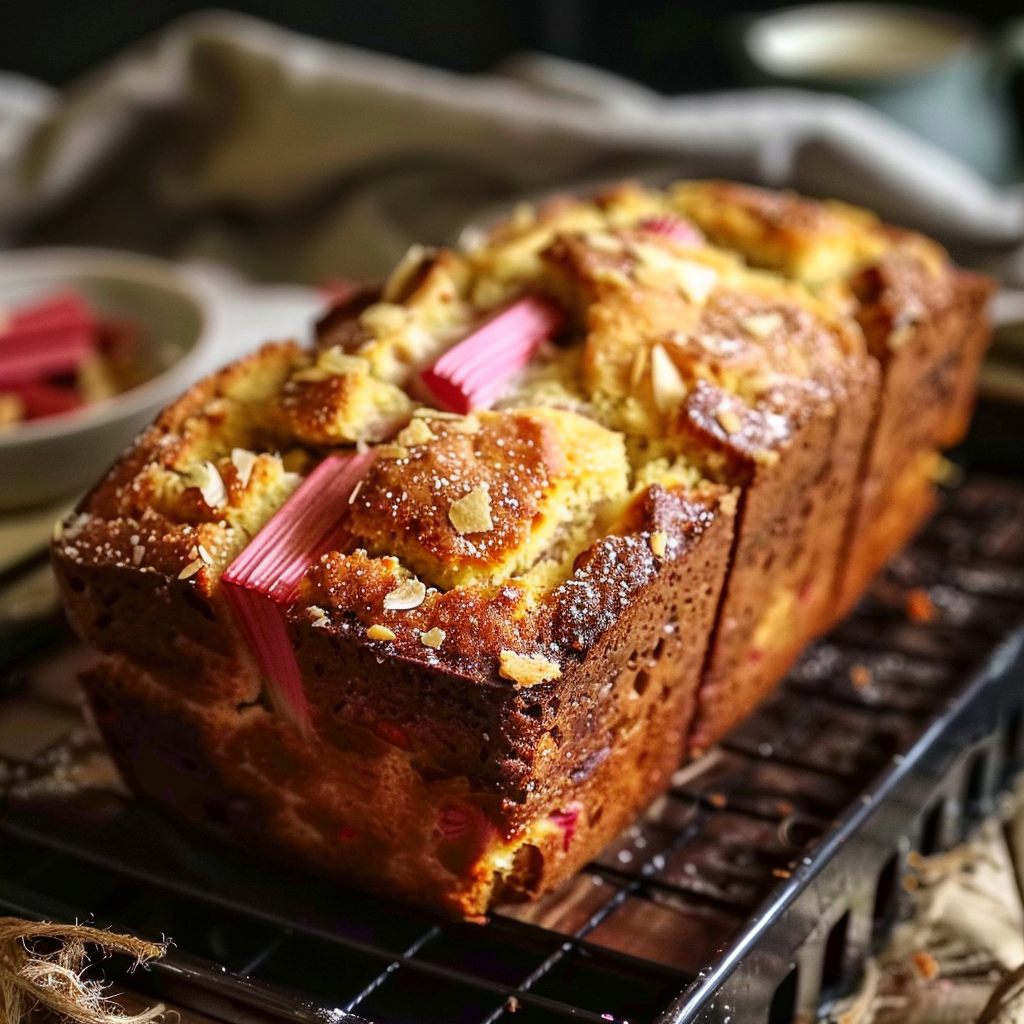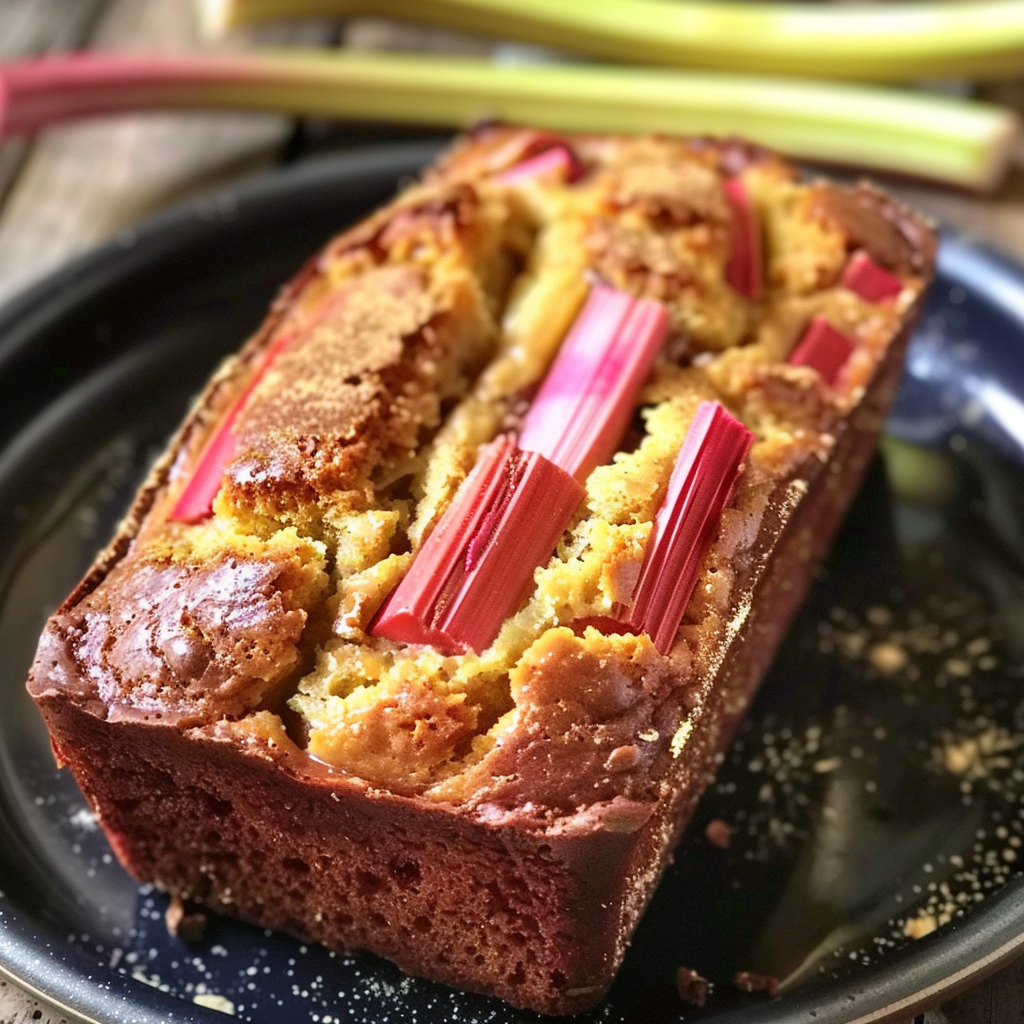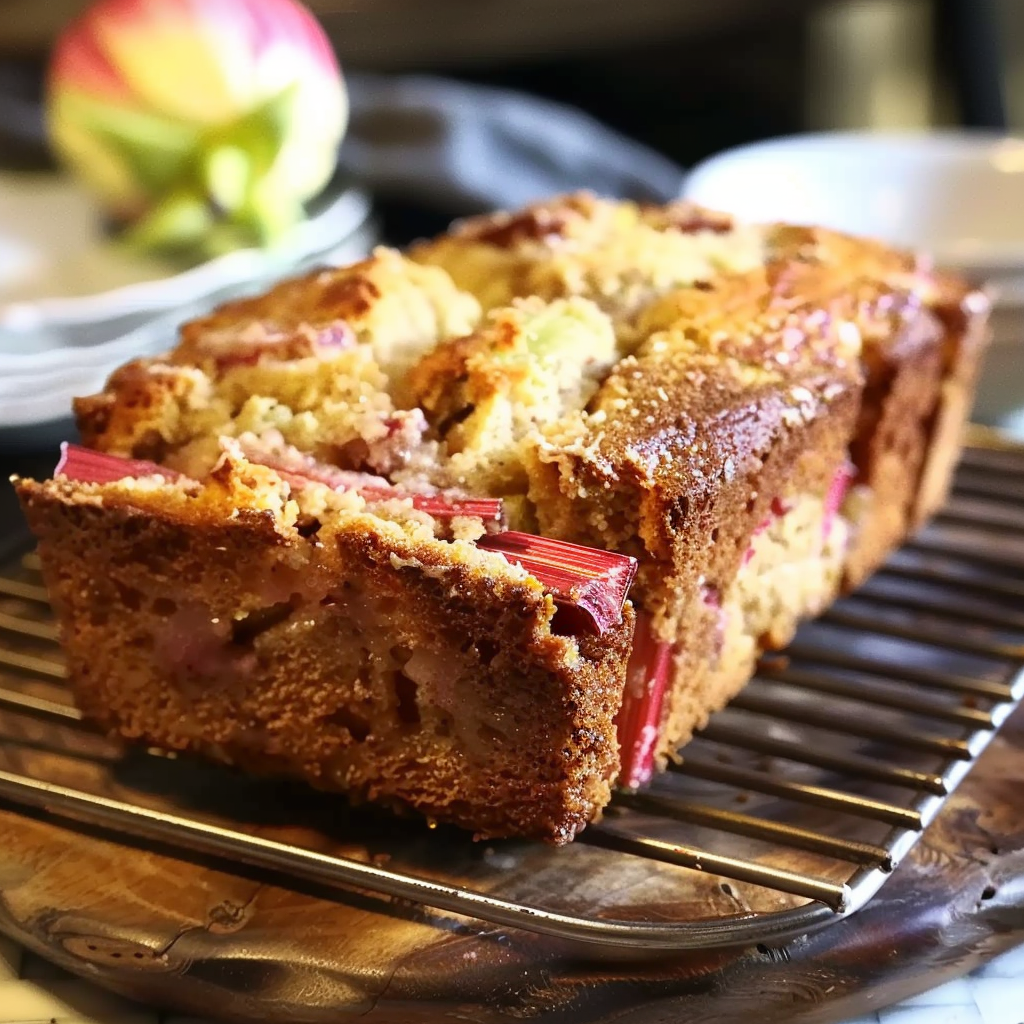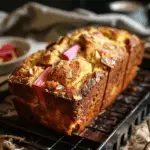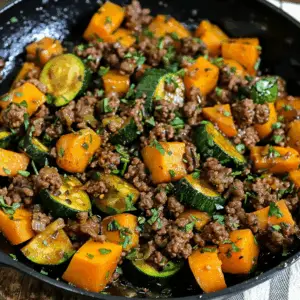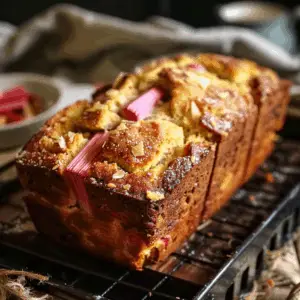1.Rhubarb Bread
Rhubarb bread is the cozy comfort food you didn’t know your kitchen needed. Whether you’re a seasoned baker or a weekend baking enthusiast, this quick bread delivers a moist crumb, a crisp cinnamon sugar crust, and the nostalgic flavor of early summer. With a simple, one-bowl method and easy-to-source ingredients, you can turn fresh or frozen rhubarb into a loaf that’s equal parts rustic and rewarding.
What makes this rhubarb loaf stand out is its balance between sweet and tart, thanks to the vibrant chunks of rhubarb and warm notes of cinnamon. If you’re new to baking with rhubarb, it’s a vegetable that acts like a fruit, prized in pies, jams, and breads. You can learn more about its culinary uses from this detailed Wikipedia guide on rhubarb.
This particular recipe creates the perfect moist rhubarb loaf using a mix of brown sugar, buttermilk, and vegetable oil—ingredients that work together to produce a soft texture that keeps well for days. For those wondering about the science behind this texture, quick breads rely on chemical leavening agents instead of yeast, making them faster and more forgiving for casual bakers. This allows for a faster mix-and-bake process without compromising on flavor or structure.
Pair this loaf with your morning coffee, serve it as an afternoon treat, or even turn it into dessert with a dollop of whipped cream. No matter how you slice it, this cinnamon rhubarb bread is a dependable recipe you’ll want to pin to your favorite baking boards on Pinterest.
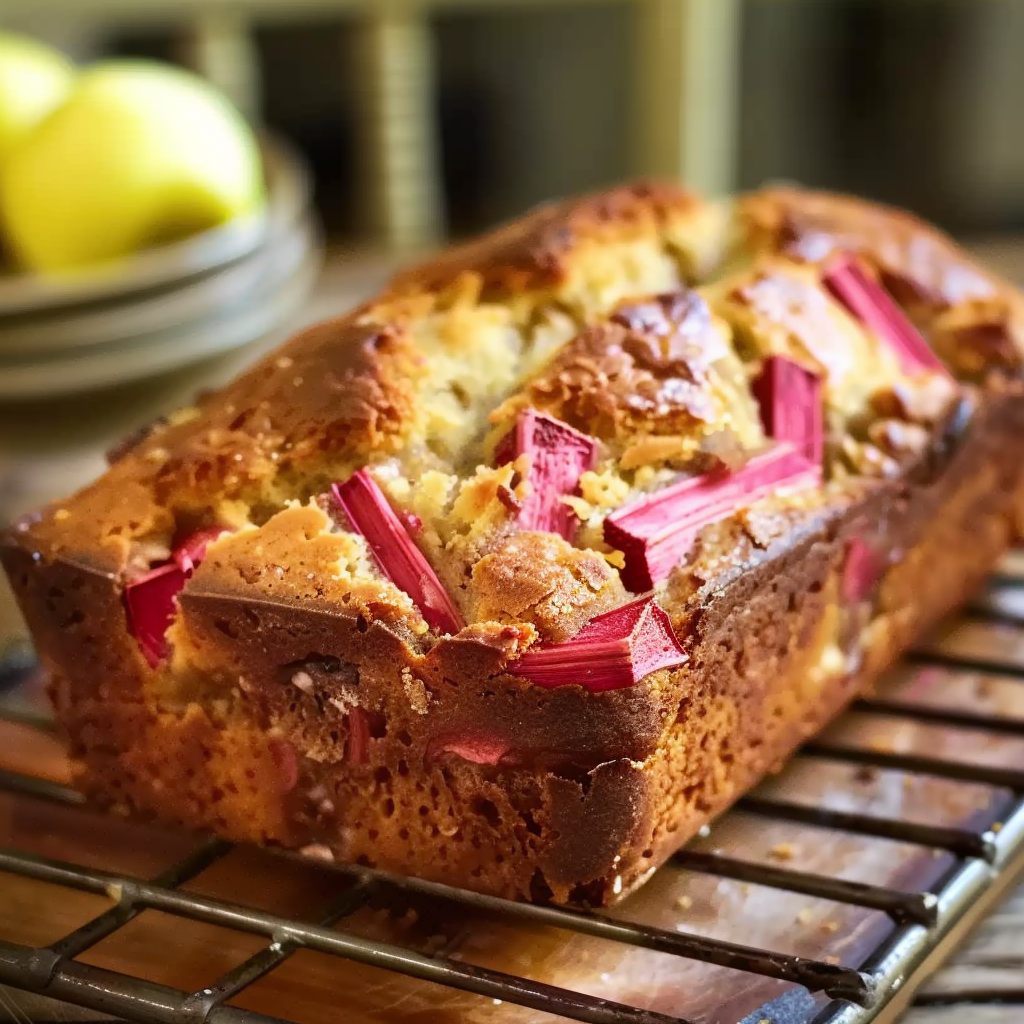
2. What Is a Quick Bread?
Quick breads are a cornerstone of home baking—ideal for those who want homemade flavor without the wait. Unlike traditional yeast breads, which require rising time, quick breads use chemical leaveners like baking soda or baking powder to rise. This creates a faster, simpler process that’s perfect for busy kitchens or last-minute baking sessions.
These breads are mixed using the muffin method: combine dry ingredients in one bowl, wet ingredients in another, then gently fold them together. Overmixing can lead to dense, rubbery textures, so gentle stirring is key. This approach is especially important when working with delicate additions like fresh rhubarb, which can release extra moisture if over-handled.
Classic examples of quick breads include banana bread, zucchini bread, and scones—but rhubarb loaf brings a unique twist with its tart bursts of flavor and vibrant color. The use of buttermilk in the batter, as in this recipe, not only adds moisture but also reacts with baking soda for optimal lift. Learn more about the chemistry of buttermilk in baking, which contributes to the soft crumb we love in quick breads.
This baking style is flexible and forgiving, making it ideal for experimentation. Want to explore beyond rhubarb? Discover a variety of quick bread ideas on Pinterest for inspiration. Whether you’re adding seasonal fruits, spices, or even savory elements, the quick bread method stays the same—simple, fast, and flavorful.
For best results, always:
-
Measure your ingredients accurately.
-
Use room temperature wet ingredients.
-
Avoid overmixing once dry ingredients are added.
-
Bake in a properly sized and greased loaf pan—more on that here.
Mastering the basics of quick breads opens the door to countless baking possibilities, and the rhubarb cinnamon loaf is the perfect place to start.
3. Why Rhubarb Shines in Baking
Rhubarb might not be the most common baking ingredient, but it offers a unique combination of tartness and texture that transforms simple recipes into unforgettable treats. In a sweet loaf like this one, its naturally sharp flavor cuts through the richness of brown sugar and oil, delivering a vibrant contrast that elevates every bite.
Technically a vegetable, rhubarb is often treated like a fruit in baking. Its crisp, celery-like stalks break down during baking to become soft and tender, adding moisture and visual appeal. For those curious about its background and botanical details, this Wikipedia article on rhubarb offers an excellent overview.
When choosing rhubarb for your loaf:
-
Look for firm, brightly colored stalks—the redder the stalk, the sweeter the flavor.
-
Avoid leaves entirely, as they are toxic.
-
If using frozen rhubarb, thaw and drain it well to prevent excess moisture from affecting the batter.
For additional rhubarb inspiration, you can check out Pinterest’s best rhubarb dessert recipes, which include everything from pies to crisps to quick breads.
One reason rhubarb bread works so well is its balance with warm spices. The cinnamon topping in this recipe helps mellow rhubarb’s tartness while creating a crusty, fragrant finish. If you want to experiment, consider complementary spices like nutmeg or cardamom for more depth.
Overall, rhubarb is a standout ingredient that provides:
-
Tart complexity without overpowering sweetness
-
Moisture and texture for quick breads
-
Natural color that makes your loaf visually inviting
Paired with the simplicity of a quick bread method, rhubarb becomes a reliable go-to for spring and early summer baking, whether you’re preparing a breakfast loaf or an afternoon snack.
4. The Cinnamon Twist: Why It Works
Cinnamon is more than just a warming spice—it’s a strategic flavor enhancer that transforms this rhubarb loaf from basic to bakery-worthy. When used in both the batter and the topping, cinnamon adds complexity, balancing the tartness of rhubarb with aromatic sweetness and warmth. The result is a moist, soft bread with a crackly, cinnamon-sugar crust that tempts from the first slice.
What sets this loaf apart is the simple cinnamon sugar topping sprinkled just before baking. It caramelizes slightly in the oven, forming a golden-brown crust that contrasts beautifully with the tender interior. This texture contrast is especially satisfying in quick breads, where the outer crunch enhances the soft middle.
Cinnamon’s versatility makes it a staple in many sweet baked goods—from muffins and doughnuts to French toast. Its pairing with rhubarb is classic, but it also works well with apples, pears, and citrus. You can explore more creative uses of cinnamon in baking on Pinterest if you’re experimenting with flavor combinations.
According to Wikipedia’s entry on cinnamon, the spice has been used in both savory and sweet dishes across cultures for centuries. In baking, it activates the senses—adding aroma, color, and warmth that linger long after the loaf is sliced.
Benefits of using cinnamon in rhubarb bread include:
-
Aromatic balance: offsets the tang of rhubarb
-
Texture: sugar topping forms a slight crust
-
Visual appeal: golden-brown top signals homemade goodness
While this recipe keeps things simple, you could also experiment with a streusel topping, combining butter, flour, and cinnamon for a crumbly finish. But even with just two ingredients, this topping delivers a huge payoff—flavor, texture, and that irresistible cinnamon comfort.
5. Ingredient Breakdown & Substitutions
Every ingredient in this rhubarb cinnamon bread plays a specific role in creating its tender crumb, sweet-tart flavor, and perfectly moist texture. Understanding how these components work—and what you can substitute—ensures your loaf turns out beautifully every time.
Brown Sugar (1 ½ cups)
Brown sugar adds more than sweetness. It provides moisture due to its molasses content and gives the loaf a subtle caramel-like depth. If needed, you can use white sugar, but expect a lighter flavor and drier texture.
Vegetable Oil (⅔ cup)
Oil ensures the bread stays soft and moist for days. It’s a better choice than butter for longer shelf life. If you prefer butter’s flavor, you can substitute melted unsalted butter for a richer loaf. Wikipedia’s overview on quick bread baking touches on these fat choices.
Egg (1 large)
The egg acts as a binder and adds richness. For an egg-free version, use a flax egg (1 tbsp flaxseed meal + 3 tbsp water) or commercial egg replacer.
Buttermilk (1 cup)
This is key for a tender, tangy loaf. Buttermilk reacts with baking soda to help the bread rise. Don’t have buttermilk? Make your own: mix 1 tablespoon of vinegar or lemon juice with 1 cup of milk and let it sit for 5 minutes. Learn more about the science behind buttermilk in baking.
Vanilla Extract (1 tsp)
Vanilla enhances the bread’s overall flavor. A few drops of almond extract can be used instead for a slightly nutty twist.
All-Purpose Flour (2 ½ cups)
The base structure of the loaf. To make it gluten-free, substitute with a 1:1 gluten-free flour blend, such as King Arthur or Bob’s Red Mill.
Baking Soda (1 tsp)
This leavener works with the buttermilk to create rise. Double-check freshness for best results.
Salt (½ tsp)
Salt balances the sweetness and enhances flavor.
Chopped Fresh Rhubarb (1 ½ cups)
Use fresh if in season. If using frozen, thaw and drain before folding into the batter to avoid excess moisture.
Nuts (½ cup, optional)
Walnuts or pecans add crunch and richness. Pecans, in particular, pair well with the warm spices and can boost texture. Learn more about pecan nutrition to decide if they fit your preference.
Cinnamon Sugar Topping
Made with ⅓ cup granulated sugar and 1 teaspoon cinnamon. This forms a deliciously crunchy top layer when baked. It’s easy, but delivers bakery-level results.
For a visual reference on how to prep and measure your ingredients, check Pinterest’s buttermilk baking tips, which can help beginners avoid common mixing issues.
6. Tools & Prep Tips Before You Bake
Having the right tools and prep techniques in place ensures this cinnamon rhubarb loaf turns out as intended—tender, moist, and evenly baked. Here’s what you need and how to use it:
9×5-inch Loaf Pan
Use a standard metal or glass loaf pan. Grease it well or line it with parchment paper for easy removal. For more info, read this guide to loaf pans on Wikipedia.
Mixing Bowls
Use at least two: one for wet ingredients and one for dry. This separation helps avoid overmixing, a key tip for soft quick breads.
Spatula or Wooden Spoon
To fold in the ingredients gently and evenly without deflating the batter.
Measuring Cups and Spoons
Accurate measurements make all the difference. Use dry measuring cups for flour and sugar, and liquid cups for buttermilk and oil.
Toothpick or Cake Tester
Essential for testing doneness. Insert into the center of the loaf—if it comes out clean or with a few moist crumbs, it’s ready.
Cooling Rack
Let the loaf cool in the pan for 10 minutes, then transfer to a wire rack to cool completely. This keeps the crust crisp and prevents sogginess.
Prep Tips:
-
Always preheat your oven to 350°F (175°C).
-
Chop the rhubarb into small, even pieces—no larger than ½ inch.
-
Don’t thaw rhubarb in the microwave; let it defrost in a colander to drain naturally.
-
Mix until just combined. Overmixing activates too much gluten and makes the bread tough.
-
Sprinkle the cinnamon sugar topping evenly right before baking.
For more visual tips on baking preparation, explore Pinterest’s easy quick bread boards, where similar recipes are broken down step-by-step.
7. Step-by-Step Rhubarb Loaf Recipe
Here’s how to make this cinnamon rhubarb bread from start to finish:
1. Mix the Wet Ingredients
In a large mixing bowl, whisk together 1½ cups brown sugar, ⅔ cup vegetable oil, 1 large egg, 1 cup buttermilk, and 1 teaspoon vanilla extract until smooth.
2. Mix the Dry Ingredients
In a separate bowl, combine 2½ cups all-purpose flour, 1 teaspoon baking soda, and ½ teaspoon salt.
3. Combine Wet and Dry
Gradually stir the dry ingredients into the wet, mixing gently until just combined. Avoid overmixing to keep the loaf tender.
4. Fold in the Rhubarb and Nuts
Gently fold in 1½ cups chopped rhubarb and ½ cup chopped walnuts or pecans (optional) using a spatula.
5. Prepare the Topping
In a small bowl, mix ⅓ cup granulated sugar with 1 teaspoon ground cinnamon.
6. Fill the Loaf Pan
Pour the batter into a greased 9×5-inch loaf pan and spread evenly. Sprinkle the cinnamon sugar mixture over the top.
7. Bake
Bake at 350°F (175°C) for 50–60 minutes. Check doneness by inserting a toothpick into the center—it should come out clean or with a few moist crumbs.
8. Cool and Serve
Let the loaf cool in the pan for 10 minutes before transferring to a wire rack to cool completely. Slice and enjoy plain, or with butter.
For creative presentation ideas or flavor twists, see Pinterest’s top rhubarb baking pins.
8. Rhubarb Bread Variations
Once you’ve mastered the basic rhubarb loaf, it’s easy to adapt the recipe to suit different tastes or dietary needs.
Flavor Variations:
-
Add 1 tsp orange zest to the batter for a citrus twist.
-
Swap vanilla extract for almond extract for a nutty undertone.
-
Fold in ½ cup white chocolate chips for a sweet contrast.
Format Variations:
-
Use a muffin tin for rhubarb cinnamon muffins (reduce bake time to 20–25 minutes).
-
Divide batter between two mini loaf pans for giftable loaves.
Dietary Substitutions:
-
Use gluten-free flour for a GF-friendly version.
-
Replace buttermilk with plant-based yogurt and egg with a flax egg for a dairy-free, vegan option.
Explore other fun spins on this recipe by browsing Pinterest’s baking variation boards, which offer seasonal and allergy-friendly ideas.
9. How to Store & Freeze Rhubarb Bread
Proper storage keeps your rhubarb cinnamon bread moist and flavorful for days.
Room Temperature
Wrap cooled loaf in foil or store in an airtight container for up to 3 days.
Refrigerator
Extend shelf life by refrigerating for up to 5 days. Bring slices to room temperature or warm slightly before serving for best texture.
Freezer
Wrap loaf tightly in plastic wrap, then foil. Freeze for up to 3 months. For individual servings, slice before freezing and separate slices with parchment paper.
To reheat:
-
Thaw at room temperature
-
Toast slices lightly or microwave for 10–15 seconds
Following these tips ensures your bread tastes freshly baked every time.
10. Serving Suggestions
This rhubarb loaf is versatile enough to enjoy at any time of day.
Simple Pairings:
-
Serve warm with a pat of butter or spread of cream cheese.
-
Pair with black coffee or chamomile tea.
Turn It Into Dessert:
-
Top with a scoop of vanilla ice cream.
-
Add a drizzle of honey or warm fruit compote.
Entertaining Tip:
Slice and serve on a wooden board with fresh fruit and nut butter for a rustic brunch centerpiece.
11. Common Mistakes & Troubleshooting Tips
Even easy recipes can go wrong—here’s how to fix common issues.
Bread Too Dense
-
Cause: Overmixing or expired baking soda
-
Fix: Mix until just combined, and check your leaveners
Too Wet or Gummy
-
Cause: Undercooked or rhubarb too watery
-
Fix: Bake longer, and drain frozen rhubarb thoroughly
Cinnamon Topping Sinks
-
Cause: Batter too thin
-
Fix: Ensure batter consistency isn’t overly loose
Cracks on Top
-
Cause: Oven too hot or wrong pan size
-
Fix: Use a 9×5 pan and test oven temperature with a thermometer
Check Pinterest’s troubleshooting guides for visual comparisons and tips.
12. FAQs: Rhubarb Bread Questions Answered
Can you use frozen rhubarb in quick bread?
Yes, just thaw and drain it well to prevent extra moisture from making the bread soggy.
Why is my rhubarb bread soggy?
It’s likely underbaked or you used too much wet rhubarb. Always test with a toothpick and measure rhubarb properly.
Can you reduce sugar in rhubarb bread?
You can reduce by up to ¼ cup, but keep in mind it may change the moisture and flavor balance.
Should I peel rhubarb before baking?
No need to peel—just trim the ends and remove any stringy bits. The skin softens during baking.
Is rhubarb safe to eat raw?
Yes, the stalks are safe and often used raw in salads. However, never eat the leaves, as they’re toxic. Learn more on Wikipedia.
Quick Bread Perfection How to Make a Soft Rhubarb Loaf
This Cinnamon Rhubarb Loaf is a moist and tender quick bread featuring tart rhubarb, warm cinnamon, and a crackly sugar crust. Made with buttermilk, brown sugar, and vegetable oil, it mixes in minutes and bakes into a comforting loaf that’s perfect for breakfast, snack, or dessert. Whether you’re using fresh or frozen rhubarb, this foolproof recipe guarantees soft texture, balanced flavor, and a beautiful golden top. It’s a timeless favorite that’s easy to make and even easier to love.
- Author: Clara
Ingredients
- 1 1/2 cups brown sugar
- 2/3 cup vegetable oil
- 1 large egg
- 1 cup buttermilk
- 1 teaspoon vanilla extract
- 2 1/2 cups all-purpose flour
- 1 teaspoon baking soda
- 1/2 teaspoon salt
- 1 1/2 cups chopped fresh rhubarb
- 1/2 cup chopped walnuts or pecans (optional)
For the cinnamon topping:
- 1/3 cup granulated sugar
- 1 teaspoon ground cinnamon
Instructions
In a large bowl, whisk together brown sugar, vegetable oil, egg, buttermilk, and vanilla extract until smooth.
In a separate bowl, mix flour, baking soda, and salt. Gradually add the dry ingredients to the wet mixture, stirring until just combined.
Fold in chopped rhubarb and nuts if using.
Pour the batter into a greased 9×5-inch loaf pan.
In a small bowl, combine granulated sugar and cinnamon. Sprinkle evenly over the top of the batter.
Bake at 350°F (175°C) for about 50–60 minutes, or until a toothpick inserted into the center comes out clean.
Let the bread cool in the pan for 10 minutes before transferring it to a wire rack to cool completely.
Slice and serve plain or with a spread of butter.
Notes
-
Make sure to chop rhubarb evenly for consistent baking.
-
Drain frozen rhubarb thoroughly before use.
-
Don’t skip the cinnamon sugar topping—it adds crunch and flavor.
-
Store leftovers wrapped tightly at room temp for 3 days or freeze for longer shelf life.
-
Serve plain, with butter, or dress it up with whipped cream or ice cream.
